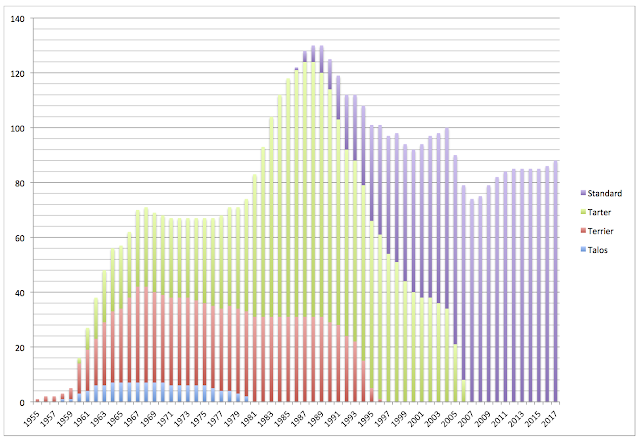The US Guided Missile Force (1955-2017)
After having examined the incredible effectiveness of even an early guided missile ship in surface warfare a few days ago, I became interested in creating a chart of the growth of the US Navy's guided missile force to compare with the decline of the US Navy's battleship and gun cruiser fleet that I made last month.
As we can see, there were two large peaks - one in the early 1960's when the ships were being built as fast as possible, and a second in the mid 1980's when the Perry's (along with the Kidd-class and Ticonderoga-class) hit the fleet in numbers. But what I found particularly interesting was that even with the massive fleet drawdown at the end of the Cold War, the guided missile fleet barely declined in numbers and actually greatly increased in capability as old Terrier and Tarter ships were replaced with Aegis destroyers.
Interestingly, there doesn't appear to be any real correlation between the decline of one and the rise of the other. The number of gun ships was trending downwards even before the missiles ships began hitting the fleet in number, and the total number of missile ships built far surpasses the number of gun ships. This suggests that countering the small Soviet cruiser force was far less important in deciding the number of guided missile ships than the need to provide a sufficient number of air defense escorts for the carriers and other surface formations. It would even hint that the United States Navy was not particularly concerned about the Soviet cruisers, and saw its carriers and destroyers as a more than sufficient counter.
The USN Guided Missile Fleet
Before comparing the two, let's look at the missile chart as it has some interesting information. For some additional detail I broke the ships down by launcher - the Terrier and Tartar categories also include Standard ER and Standard MR, respectively, while the Standard category only covers VLS ships (which, it should be remembered, didn't have an ER missile until 1999). Unfortunately, I don't have good information on the exact dates the Perry's lost their Mk 13 launchers so the final 3 years of Tarter are merely a best guess based on available information. |
| Chart of all commissioned US Navy guided missile ships (1955-2017) |
As we can see, there were two large peaks - one in the early 1960's when the ships were being built as fast as possible, and a second in the mid 1980's when the Perry's (along with the Kidd-class and Ticonderoga-class) hit the fleet in numbers. But what I found particularly interesting was that even with the massive fleet drawdown at the end of the Cold War, the guided missile fleet barely declined in numbers and actually greatly increased in capability as old Terrier and Tarter ships were replaced with Aegis destroyers.
Another thing I found interesting was that only seven Talos ships were built and the system barely lasted 20 years. It definitely seems that when it was found that a rocket-based missile could meet the program objectives for Project Bumblebee, they should have just cancelled the ramjet project instead of giving it a more challenging objective. While the austere conversions would have retired around the same time, the Boston-class missile cruisers would likely have lasted longer and the extra time and money spent on Talos could have gone towards more ships.
Finally, I was surprised at the fairly even division between Terrier and Tartar ships before Standard was introduced in the 1970's. When you consider that only two classes (Charles F Adams and Brooke) were built with Tartar as their main battery and that the Spruance-class downgraded to Sea Sparrow, it raises the question of whether the Navy considered it a failed system.
Missiles vs Guns
Now let's compare the rise of the missile ship with the decline of the gun ship (with gun ship taken to mean vessels with 6" or larger guns and no guided missiles).
 |
| US Navy guided missile ships and large caliber (6"+) gun ships (1950-1980) |
Interestingly, there doesn't appear to be any real correlation between the decline of one and the rise of the other. The number of gun ships was trending downwards even before the missiles ships began hitting the fleet in number, and the total number of missile ships built far surpasses the number of gun ships. This suggests that countering the small Soviet cruiser force was far less important in deciding the number of guided missile ships than the need to provide a sufficient number of air defense escorts for the carriers and other surface formations. It would even hint that the United States Navy was not particularly concerned about the Soviet cruisers, and saw its carriers and destroyers as a more than sufficient counter.


